
Volume 7, Number 6
Dec 1983
The Inserted-Flange Case Binding Structure for
Rebinding Heavy Folios Without Leather
by Scott Kellar
private conservator, Chicago
As a great many library reference works have either been
published as heavy folio volumes in "inadequate" (to be polite) case
bindings, or given leather bindings that are now deteriorated, it is
hoped that this structure will find an application. Designed for
utility and endurance, it is meant to provide an economical binding
alternative for heavy folios for which leather is not deemed
appropriate or desirable. Characteristics of both Birdsall's and
Harrison's adaptations of the split-board construction1 are integrated for their combined
advantages. This structure includes a stab-sewn cloth-joint endsheet
which assumes the volume has moderate-to-heavy shoulders and is not
to be resewn.
Although questions may legitimately be raised with regard to the
appropriateness of stab sewing through the shoulders (a topic of
high mileage), it is well to note that the original bindings of a
definite majority of these books include stab-sewn or overcast
shoulders, especially in those published from the early nineteenth
century on. Removing this original sewing is unnecessary and often
disastrous. This type of volume usually functions well, by wear
and/or design, without the first and last few sections opening
completely to the spine fold. Stab sewing in rebinding can securely
attach a cloth joint at the same time it reinforces the original
stab sewing. If the volume does not have this original stab sewing
through the shoulder, it is indeed up to the binder to decide
whether or not that particular book will benefit by introducing it.
In general, the heavier the shoulders, the more likely a binding of
"stout" construction will benefit from its use. Simple modifications
may be made in the following description to omit stab sewing if it
is deemed preferable.
In the method described below, the specifications of many
materials (linings, cloth, tapes, etc.) are left to the discretion
of the binder. The use of a hollow tube (oxford hollow) on the spine
is optional.
Preparation
- Remove spine adhesive from the book block.
- Mend tears, clean pages.
- Secure loose pages; reinforce with japanese tissue at gutter if
weak or brittle.
Cloth Joint Endsheet Construction (Figures 1-3)
- Tip 3" linen strips of suitable weight and strength to the
shoulders with PVA.
- Pierce holes through to the spine at the base of the shoulders
approximately 3/4" to 1-1/4" apart. Stitch in and out of these holes
with strong thread. Draw the thread firmly and tie off at the first
and last holes (Figure 1).
- Apply PVA to the perpendicular surface of the shoulders, being
sure to cover the thread. Draw the linen strip back firmly away from
the base of the shoulder and rub it well against the adhered
surface.
- Prepare two double folios of strong acid-free paper, slightly
larger than the book block.
- Gently crease the folded edge of the endsheets at a distance
equal to the shoulder height.
- As each of these endsheets are tipped to the shoulders Figure
2), pull down the linen hinges over the end- sheet and crease them
at the base of the shoulders. It is important that the folded edge
of each endsheet extend completely to the edge of the shoulder.
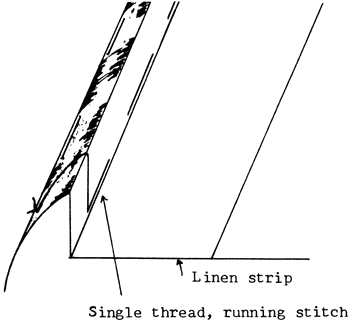
Figure 1. Stab-sewn shoulder.
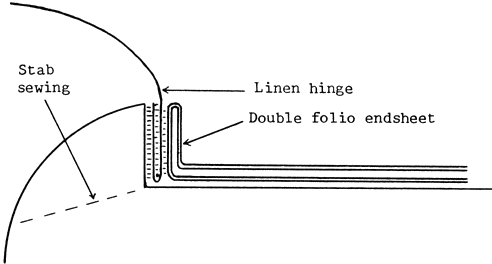
Figure 2. Hinge attachment.
- Tack linen tapes of sufficient weight and number to the spine
with PVA. These should extend at least 2" onto the sides of the book
block.
- Sew the double-folio endsheets through the fold onto these tapes
(Figure 3), tying off the thread at head and tail to the previous
stab-sewing. This "double sewing" provides a secure attachment of
the hinge cloth to both the base and the outer edge of the
shoulders.

Figure 3. Endsheet attachment.
Forwarding
- Trim the endsheets at head and tail.
- Round as necessary.
- Back the book and set the spine (this consolidation helps the
spine to retain its shape on the shelf). This may be done by
moistening the spine while it is in the backing press with methyl
cellulose or paste. After allowing it to absorb as much moisture as
possible, scrape off the excess and rub it down with a folder. Allow
to dry in the press overnight.
- While the book is still in the backing press, add appropriate
spine linings and allow to dry.
- If desired, a hollow tube may be added to the spine at this
point.
Forming the Flanges
- Cut a strip of acid-free file folder stock for each flange, the
height of the volume by 2", grain short.
- Brush PVA on the outside of the endsheet under the extending
cloth joint only, and rub down the joint.
- Adhere the tapes onto the cloth joint.
- Brush PVA onto one side of the file folder strip, place it up to
the base of the shoulder and rub it down.
- Brush out the foredge half of the outside endsheet and fold it
up to the base of the shoulder, even with the file folder strip. Rub
it down. (Figure 4)

Figure 4. Flange construction.
- Repeat Steps 2-5 for the other flange.
- Put tins under the flanges up to the shoulders and press till
dry. Later the flanges will be trimmed on all three edges to fit
into recesses in the boards (Step 6 in the next section; Figure
7).
Recessed Laminated Board Construction (Figures 5 and 6)
- Quarter cloth: Cut all board heights (vertical grain) to
the book block height plus 1/4" (squares are best kept small on
heavy volumes to minimize possible sagging). Board width may be cut
oversize and trimmed after the cover is attached.
Full cloth: Board height as above. Board width should be the
width of the book block from foredge to base of shoulder less 1/8".
This allows for an average 1/4" distance between shoulder and board
in the bound book. If the shoulders are higher than 1/4", the boards
should be that much narrower; if they are not that high, the boards
should be that much wider. See Case Construction, Step 1,
below.
- Use boards of a thickness which, together with one 2-ply board
and one thickness of thin acid-free flexible board (about .15", or
like chipboard), will equal the height of the shoulder.
- Add the 2-ply board by laminating a piece (Figure 5, b) the same
size as the board less 1-1/4" in width. A 1-1/4" 2-ply strip (Figure
5, c) is cut and attached at the inside margin, but adhered only
3/4" in from either end (Figure 6, c).
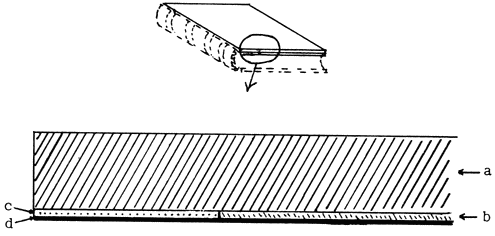
Figure 5. Laminated cover board, viewed from end.
a. Binders board.
b. Two-ply board 1-1/4" narrower than a, abutting c, adhered to a
and d.
c. Two-ply strip, 1-1/4" wide, adhered for only 3/4" at head and
tail to a and d.
d. Thin board, same size as a.
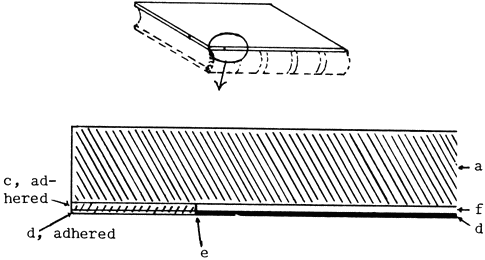
Figure 6. Laminated cover board, viewed from
inside edge.
a. Binders board.
c. Adhered part of 2-ply strip.
d. Adhered part of thin board.
e. Cut (incision).
f. Unadhered portion of 2-ply strip.
- The thin board (Figure 3, d) is cut the same size as the
binder's board and is laminated, leaving the inside margin (1-1/2")
unadhered. Adhesive is added 3/4" in from either end of this flap
(Figure 6, d).
- After all is dry, cuts (Figure 6, a) are made 3/4" in from the
ends of the inside margin, penetrating both the thin board and the
2-ply board. The cuts extend 1-1/4", enough to free the unadhered
portion of the 2-ply strip. Remove but do not discard it.
- Trim the flanges to fit easily within these recesses, allowing
about a 1/4" space between the shoulder and board (Figure 7).
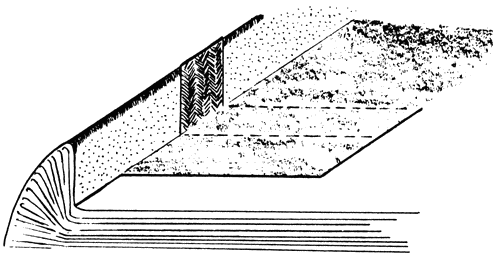
Figure 7. Trimmed flange.
- Tack the 2-ply strip pieces back into the same recesses with
dots of adhesive.
Case Construction and Attachment (Figure 8)
- The case is made off the book. Keep the width of the cloth
turn-ins under 3/4", to avoid obstructing flange insertion.
Acid-free file folder stock may be used for the case spine strip; if
a hollow tube has been used, a lighter paper should be substituted.
Because of the depth of the french groove, the boards should be laid
on the glued-up cloth further away from the spine strip than usual
for smaller books. The distance should be about twice the shoulder
height: a 1/2" joint width for a book with 1/4" shoulders seems
appropriate. Add pieces of cord of suitable thickness at the head
and tail of the spine strip.
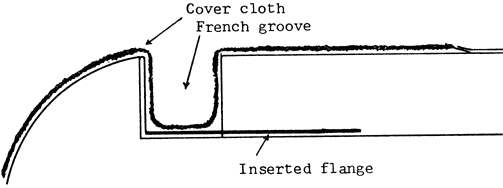
Figure 8. Outside joint (french groove).
- Directly after the case is made, insert the book block into it
and work down the french grooves with the bone folder to give the
case its shape. Mold the endcaps. Allow the case to dry under a
light weight.
- Remove the case from the book block, noting front and back board
positions.
- The case may be lettered with a stamping press at this point if
preferred. Alternatively, tooling or label may be added as a final
step.
- Case in. Brush the joints of the case carefully with PVA; if a
hollow tube is used, glue this up as well. Reinsert the book block,
rub down the spine if necessary, and set the french grooves with
appropriate diameter wooden or aluminum rods until dry.
- If the case is quarter cloth, trim the board foredges to provide
even squares. Add vellum tips if desired, and add cloth or paper
sides.
Insertion of Flanges and Finishing
- Open one board and pop out the recess filler piece.
- Brush PVA onto the outside of the flange and insert it into the
recess.
- Close the board and immediately check the groove and foredge
square--it may be necessary to slide the board back toward the
shoulder slightly to regain a well- shaped french groove and proper
foredge square.
- Repeat 1-3 for the opposite board.
- Press till dry.
- Adhere the inside margin of the thin board laminate (covering
flange) and press again.
- Paste in the endsheets and press the book (boards closed) till
dry.
- Add label or tooling if any.
Bernard Middleton. A History of English
Craft Bookbinding Technique. London: The Holland Press, 1978.
Pages 76-78, 81.
![[Contents]](../../img/contbtn.gif)
![[Search]](../../img/srchbtn.gif)
![[Abbey]](../../img/abbbtn.gif)









